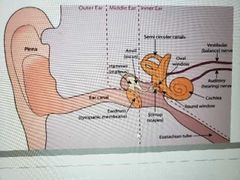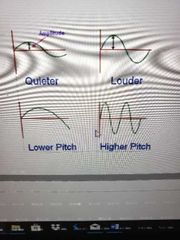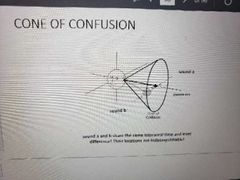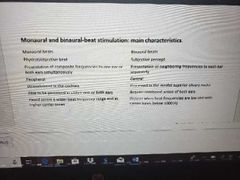![]()
![]()
![]()
Use LEFT and RIGHT arrow keys to navigate between flashcards;
Use UP and DOWN arrow keys to flip the card;
H to show hint;
A reads text to speech;
31 Cards in this Set
- Front
- Back
- 3rd side (hint)
|
Auditory oathway |
Cochlea to auditory nerve to primary auditory cortex |
|
|
|
Tonitopic organization |
Organization of neurons according to the frequencies to which they respond |
|
|
|
Sounds of analysis:what and where system |
What: frontal and temporal lobe Where: auditory core region, parietal lobe and occipital lobe |
|
|
|
Ear anatomy |

|
|
|
|
Ossicles amplify sound |
necessary so that air vibrations in outer and middle ear can lead to fluid vibrations in inner ear |
|
|
|
Pitch waves |

|
|
|
|
Arnorlds reflex |
Occurs on 2% of people Stimulation in auditory canal Results in cough More common in women |
|
|
|
Ninaraul cue: internal time difference |
Uses the time it takes sound to reach left and right ear to localize sound Effective for low cues |
|
|
|
Binaural cue: interaural level difference |
Uses difference in sound levels that reach both ears Effective for high frequency cues |
|
|
|
Cone of confusion |

|
|
|
|
Monaural spectral cue |
Unique fold of pine reflect sound into ear canal differently depending on angle. Spectrum of frequency at as a signature for sound localization at different levels |
|
|
|
Human echolocation |
Activation in both auditory and visual cotices. Echolocation is used to navigate(when blind) Sighted people can be trained to use echolocation basics |
|
|
|
Binaural beats |
An illusory pulsing sound when two different frequencies are presented go each ear They impact brain function. Not a lot of research to back it up |
Could relieve anxiety |
|
|
Monaural vs binaural |

|
|
|
|
Temporal segregation |
Sounds occur at the same time are grouped together. Sound alternating quickly are grouped separately |
|
|
|
Spatial segregation |
Sounds that come from same location are grouped together Sound that come from different locations are grouped seperate |
|
|
|
Spectral segregation |
Sounds that overlap in frequency are grouped together Sounds that do not over lap are grouped separately |
|
|
|
Vowels |
Speech with Unrestricted air flow |
|
|
|
Consonants |
Speech sounds with restricted airflow |
|
|
|
Place of articulation |
Where restriction occurs |
B vs D |
|
|
Manner of articulation |
How restriction occurs |
B vs F |
|
|
Voicing |
If vocal cords are vibrating |
B vs P |
|
|
Phonemes |
Smallest significant unit of speech 40 in english 10-100 in other languages |
|
|
|
Morphemes |
Smallest meaningful unit of speech Words or meaningful parts (Ing, ed, un, mis) Millions of morphemes. New ones added all the time |
|
|
|
Segmentation |
No gaps in between words |
|
|
|
Invariance |
How we articulate phnomes. How we actually say them. |
|
|
|
Normalization |
Becoming use to. Depends on mood or accent of speaker |
|
|
|
General mechanisms |
Not special Top down process Speech perception occurs through same neurocognitive process as other forms |
|
|
|
Special mechanism throries |
Yes special Speech perception occurs through unique neurocognitive processes from other forms of auditory perception |
|
|
|
Motor theory of speech perception |
We perceive speech by integrating sounds to the visuals of the mouth movement s |
|
|
|
NMT axample:RAS |
Technique used to help rehabilitation development and maintenance of biological movements Use for individuals with deficits in walking/ gait abilities Works by syncronazation of the body to an external rhythm |
|

